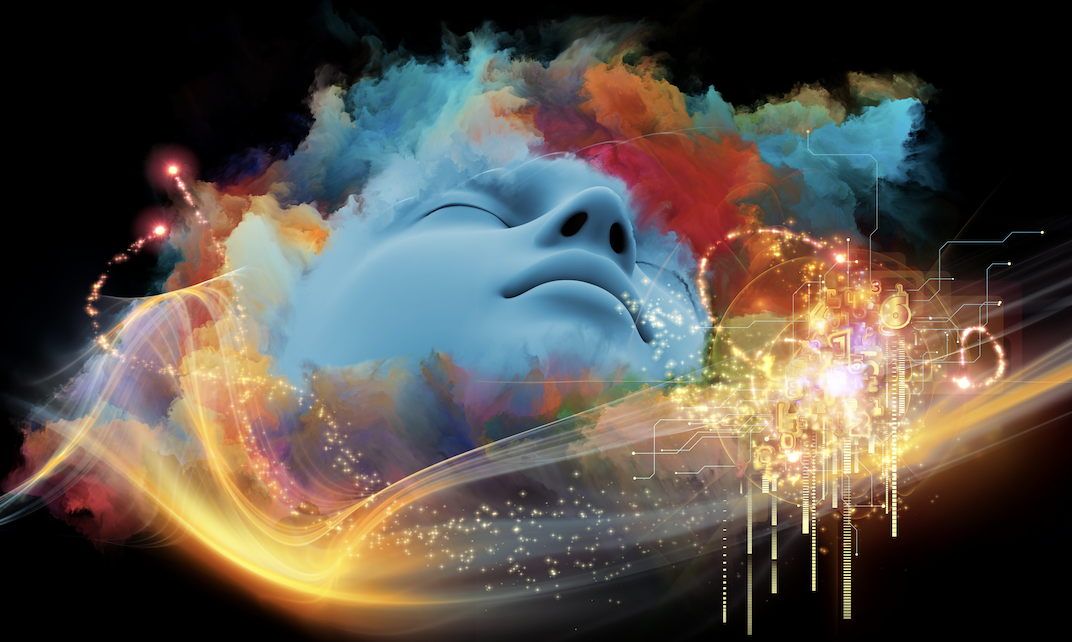How psychedelics may therapeutically alter the link between your two “selves”

- Interoception — your sense of the internal state of your body — may be deeply connected to consciousness.
- Research suggests that when interoceptive processes go awry, psychiatric disorders may ensue.
- A small but growing body of research suggests that psychedelics might be able to reveal insights about — and potentially help rectify — interoceptive imbalances.
When we think of altered states of consciousness, we tend to picture the brain or mind swirling in a psychedelic funhouse. This bias has influenced the scientific study of altered states, with psychedelic science focusing almost exclusively on the relationship between the mind and the brain. But what if consciousness has more to do with what’s below the neck than what’s between the ears?
An emerging understanding of consciousness suggests that it may be rooted more deeply than cerebral interactions — specifically, in the body’s intrinsic sense of its internal state, or “interoception.” Psychedelics could offer a window into the relationship between interoception and consciousness, potentially enabling people to experience the intricate dance between the two in novel and beneficial ways.
Feelings and consciousness
Since the publication of his book Descartes’ Error in the early 1990s, neuroscientist Antonio Damasio has maintained that “feelings are the source of consciousness.” In an article co-authored with his wife Hanna Damasio in 2023, the two scientists hypothesize that homeostatic feelings such as hunger, pain, breathing, and body temperature are the “inaugural phenomena of consciousness in biological evolution,” since the body’s ability to self-regulate “conferred extraordinary advantages to the organisms so endowed.”
Until recently, biological accounts of consciousness have largely been ignored, with scientists looking in the direction of cognitive science or physics to solve the hard problem of consciousness: the challenge of explaining why and how we have qualitative subjective experiences, often referred to as “qualia.” But Damasio argues that biology offers a solution to the mind-body problem. He writes: “Homeostatic feelings,” like hunger and pain, “constitute the ‘mental’ version of bodily processes. To be conscious consists of experiencing a correspondence between mental contents and a specific living organism.”
Other neuroscientists, including Anil Seth and Big Think contributor Moheb Costandi, have echoed similar sentiments on the relationship between interoception and consciousness in recent years. In his 2021 book Being You, Seth argues that the “most fundamental reason an organism has a brain is to help it stay alive.” Cognition, he says, has more to do with being alive than with being intelligent. The ways in which we perceive, think, and communicate all evolved to aid homeostasis. In other words, the human brain works in service of the body, not the other way around.
“Consciousness requires a partnership of nervous systems with the bodies they serve,” write the Damasios. “It does not depend on nervous systems alone.”
This partnership is called interoception, and it may play a key role in the future of psychedelic science.
What is interoception?
Interoception is the sense of the body from within — everything from hunger, pain, and pleasure to joy, anger, and sadness. The brain and body are in a constant state of communication, but only some of these processes reach our conscious awareness. Poor interoception has been associated with anxiety, depression, PTSD, eating disorders, addiction, and other illnesses. In some cases, researchers think that people pay too much attention to bodily signals (anxiety), while in other cases they pay too little attention to them (eating disorders).
Interoception is typically measured via cardiac, gastrointestinal, and respiratory signals. A common measurement method is the heartbeat detection task, which gauges how accurately people can detect their own heartbeat. This is one way to measure interoceptive accuracy. On the other hand, interoceptive awareness is a separate concept that refers to how aware you are of your perceptions of sensations from inside your body.
It is becoming clear that interoception could be just as crucial to well-being as neural circuitry or genetics. In fact, it may be fundamental to human health precisely because it is fundamental to consciousness.
Homeostasis has always been a defining feature of life, the Damasios point out, but it hasn’t always been a conscious process: unicellular organisms and other early life forms simply self-regulated without being aware of it. It wasn’t until awareness of felt experience became evolutionarily advantageous that multicellular organisms developed nervous systems.
These felt experiences came to be represented in various parts of the brain, such as the somatosensory cortex and insula. The result was a two-way street between brain and body.
“The central nervous system can react to the presence of those representations by altering the body states that originated them and consequently altering their subsequent representations,” write the Damasios. “Rather than merely perceiving the body, the brain participates in a comprehensive dialogue with structures that harbor, surround, and support the body.”
When these interoceptive processes go awry, psychiatric disorders may ensue. A growing body of research shows that psychedelics seem to be effective in treating many of these disorders.
Psychedelics and interoception
From Robin Carhart Harris’s REBUS model to Gül Dölen’s critical period theory, many explanations have been offered for how psychedelics work in the brain. As psychedelic treatments enter mainstream medicine, the precise therapeutic mechanisms remain unclear. But one clue lies in the fact that the benefits of psychedelic-assisted therapy appear to be transdiagnostic — they improve symptoms across a wide range of mental illnesses, from depression to PTSD to eating disorders. What’s more, recent studies now suggest they show promise for treating physical ailments, too, such as chronic pain from fibromyalgia.
Does this say something about psychedelics themselves, or about the connection between brain and body?
“Alterations of the bodily self (i.e., disembodiment, detachment between the body and mental processes, or blurring of boundaries between the body and environment) constitute an integral phenomenal part of the psychedelic experience,” wrote a team of psychedelic scientists at the University of Zurich, led by Dr. Katrin Preller, in a 2020 review paper.
In psychedelic science, and in Preller’s paper, researchers sometimes draw a distinction between the “narrative self” and the “minimal self,” which can help us understand how interoception fits in. The narrative self is an explicit form of self-awareness, tied to one’s body and the continuous story of “who we are.” Meanwhile, the minimal self is simply the inchoate sense of occupying a body, not unlike the moment between the end of a dream and waking life. Different disorders affect each of these “selves” in different ways, and psychedelics influence both as well. What may be more important than their differences, however, is the relationship between the two.
The essence of consciousness, write the Damasios, is “the identification of a particular mind with a particular organism.” In other words, consciousness is the link between minimal and narrative selves.
“This ‘knowledge’ is provided by the continuous experience of homeostatic feelings generated by the ongoing process of life regulation as the organism attempts to maintain operations in the homeostatic range. These include salient feelings such as pain, as well as the subtle feelings of existence that are generated continuously in the awake state.” In the normal awake state, the Damasios point out, this identification happens automatically, not as a result of overt reasoning.
In a psychedelic state, however, the usual bond between our foundational sense of presence and our life’s narrative might become less automatic. It’s possible that this unique experience — where the basic sense of being and one’s life story momentarily drift apart — could be a key therapeutic aspect of psychedelics, allowing individuals to reflect on their current state of existence without the embedded narrative of their past.
New frontiers for psychedelic science
So far, only a handful of studies have explicitly investigated the link between interoception and psychedelics. In 2015, a team led by Johns Hopkins neuropharmacologist Matthew Johnson reported that moderate doses of salvinorin-A seemed to increase body trust, a facet of interoception. While high doses led to a complete loss of contact with the body, low and medium doses “acutely led to increases in experiencing one’s body as safe and trustworthy.” Interestingly, high body trust has been shown to ward off chronic low back pain, perceived stress, depression, and anxiety.
In 2021, a group in the Netherlands found that microdosing psilocybin did not affect self-reported interoceptive awareness in a non-clinical population. In 2024, researchers at Imperial College London plan to release results on the interoceptive effects of psilocybin in an anorexic population.
Despite the dearth of interoception studies, the somatic effects of psychedelic therapy are well-documented, and there appears to be a link between bodily sensation and therapeutic effect. Many people report feeling “more connected” to themselves — not just conceptually, but experientially.
“Previous conceptualizations of ‘self-connection’ have been largely cognitive, emotional, and behavioral, and have not included embodied/somatic aspects,” writes Dr. Rosalind Watts, a clinical psychologist who studies psychedelics and connectedness. “Self-connectedness in psychedelic therapy tends to be described as connectedness to the senses, the body, and emotions.”
It’s possible — though still speculative — that altered interoception isn’t a byproduct of psychedelic therapy, but a key mechanism. As consciousness research continues to move on from a singular focus on the brain, is it time for psychedelic science to do the same?





